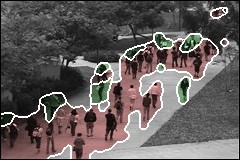
| Home | People | Research | Publications | Demos |
| News | Jobs |
Prospective
Students |
About | Internal |

| Understanding Video of Crowded Environments | |||||||||||||||||||



|
|||||||||||||||||||
|
The automated monitoring and surveillance of crowded scenes is a remarkable challenge for current image and video understanding technology. It has application in areas such as homeland security, natural disaster prevention, research on insect behavior, and monitoring of animal populations, among others. It has recently acquired strong societal significance, due to the possibility of terrorist attacks on events involving large concentrations of people, a problem for which there are currently no effective solutions. This project lays the foundation for the technology that will enable the automated monitoring and surveillance of crowded scenes, by modeling their video as a visual texture that deforms itself in stochastic but predictable ways, in response to certain events. In particular, the project aims to produce 1) a suite of generative probabilistic models for the video produced by various types of crowded scenes, and optimal algorithms for the estimation of their parameters, 2) a family of classifiers that build on these models to design detectors of important events, 3) a collection of algorithms for crowd video stabilization, segmentation, and parsing, and 4) a large database of video examples, that will establish a common experimental framework for the evaluation of future research in the field. Educationally, the project will provide research opportunities to both undergraduate students and students of underrepresented backgrounds. |
|||||||||||||||||||
| Recent Results: |
|
||||||||||||||||||
| Project/ Results: |
|
||||||||||||||||||
| Databases: |
We have gathered several databases of crowded environments.
|
||||||||||||||||||
| Publications: |
Crowd Analysis
Analysis of Crowded Scenes using Holistic Properties A. B. Chan, M. Morrow, and N. Vasconcelos In 11th IEEE Intl. Workshop on Performance Evaluation of Tracking and Surveillance (PETS 2009), Miami, June 2009. © IEEE [pdf] Privacy Preserving Crowd Monitoring: Counting People without People Models or Tracking A. B. Chan, Z. S. J. Liang, and N. Vasconcelos. In, IEEE Conference on Computer Vision and Pattern Recognition (CVPR), June 2008. © IEEE [ps][pdf] Probabilistic Kernels for the Classification of Auto-regressive Visual Processes A. B. Chan and N. Vasconcelos, Proceedings of IEEE Conference on Computer Vision and Pattern Recognition, San Diego, June 2005. © IEEE, [ps][pdf] (A longer version is available [ps][pdf]). Classification and Retrieval of Traffic Video using Auto-regressive Stochastic Processes A. B. Chan and N. Vasconcelos, Proceedings of 2005 IEEE Intelligent Vehicles Symposium, Las Vegas, June 2005. © IEEE, [pdf]. Dynamic Textures Layered Dynamic Textures A. B. Chan and N. Vasconcelos To appear in IEEE Trans. on Pattern Analysis and Machine Intelligence: Special Issue on Probabilistic Graphical Models in Computer Vision, 2009. © IEEE [ps][pdf] Variational Layered Dynamic Textures A. B. Chan and N. Vasconcelos In IEEE Conference on Computer Vision and Pattern Recognition (CVPR), Miami, June 2009. © IEEE [pdf] Modeling, clustering, and segmenting video with mixtures of dynamic textures A. B. Chan and N. Vasconcelos. IEEE Trans. on Pattern Analysis and Machine Intelligence, Vol. 30(5), pp. 909-926, May 2008. [ps][pdf]. Classifying Video with Kernel Dynamic Textures A. B. Chan and N. Vasconcelos Proceedings of IEEE Conference on Computer Vision and Pattern Recognition (CVPR), Minneapolis, May 2007. [ps][pdf] Layered Dynamic Textures A. B. Chan and N. Vasconcelos, Proceedings of Neural Information Processing Systems 18 (NIPS), pp. 203-210, Vancouver, December 2005. [ps][pdf] Mixtures of Dynamic Textures A. B. Chan and N. Vasconcelos, In IEEE International Conference on Computer Vision, Proceedings October 2005. © IEEE, [ps][pdf]. The EM algorithm for mixtures of dynamic textures A. B. Chan and N. Vasconcelos, Technical Report SVCL-TR-2005-01, March 2005. [ps][pdf]. Efficient Computation of the KL Divergence between Dynamic Textures A. B. Chan and N. Vasconcelos, Technical Report SVCL-TR-2004-02, November 2004. [ps][pdf] |
||||||||||||||||||
| Contact: | Antoni Chan, Nuno Vasconcelos | ||||||||||||||||||
![]()
©
SVCL